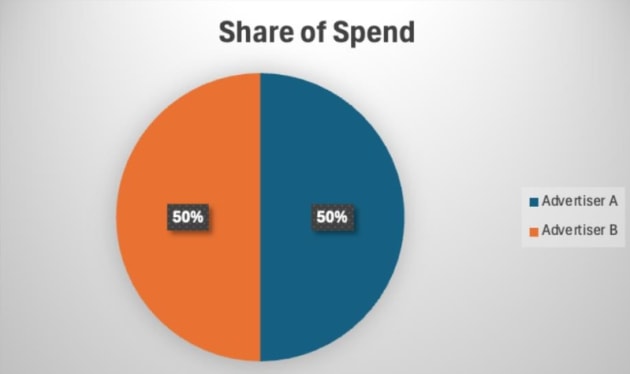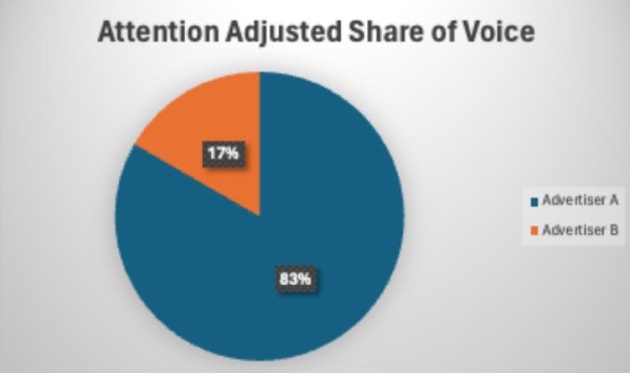
In the dynamic space of attention-focused media planning and buying, industry leaders have done an excellent job in championing the important role of attention. But while the industry is moving towards planning beyond the conventional metrics of reach and frequency, it still feels as though the puzzle is missing a critical piece, and that missing piece is slowing progress.
With the current industry standard of competitive reporting, a standard share of voice analysis essentially looks at ‘share of spend’. The issue here is that this analysis assumes all channel spends are measured equally, when in fact, each channel has a different level of attention and isn’t like-for-like.
For example, advertiser A might spend $500K on TV while advertiser B spends $500K on display. If we were to apply a standard share of spend calculations, both advertisers would have the same share of voice.
But if we consider the theory that not all channels deliver the same level of attention, the share of spend is ultimately flawed: it doesn’t give advertisers the full picture of where they sit within their category, potentially misleading them into thinking their share of voice is higher than it really is.
So, how can we show clients their share of voice while taking attention into consideration? I’ve developed a simple but reliable metric which calculates attention-adjusted share of voice.
It starts by nominating a score out of one for what the attention of each channel, then applying that score to the spend against each channel across every advertiser (note: attention scores will need to be developed through a variety of external data points and media mix modelling as it will vary by audience and category).
Let’s use the first example to apply my Attention-Adjusted Share of Voice Theory:
Advertiser A: $500K – Display Only
Advertiser B: $500K – TV Only
Dummy Attention Score by Channel:
TV: 0.60
Display: 0.12
Applying Attention Score to Spend:
Advertiser A:
500,000 x 0.60
= $300,000
Advertiser B:
500,000 x 0.12
= $60,000
The below reflects what Share of Voice actually looks with the help of an attention score:
When overlaying an attention score to spend by channel, you get a very different view of your share of voice compared to looking at share of spend alone. It also means that channels with higher attention are being rewarded, while channels with lower attention are being adjusted accordingly.
Now, like anything, this is still not perfect. Obviously, you are assigning an attention score to an entire channel when attention might differ by format. Additionally, channels like social have a mix of low-attention and high-attention formats, so the overall channel might be penalised unfairly. But it won’t be long until our competitor tools become more robust and more data is made available on attention by format. Once this happens, our attention scores can begin to account for the nuances in attention by format, leading to a more accurate and richer representation of share of voice.
I’m not suggesting that I’m the first person to criticise ‘share of spend’ either. Media science researcher and CEO of Amplified Intelligence, Karen Nelson-Field, has been strongly arguing this point since 2021. She argues: “If you're overspending on low attention platforms and underspending on high attention platforms while your competitors are doing the opposite, the principles of share of voice will fail.”
Despite this, I want to be clear that I don’t believe the solution is to disregard share of spend altogether, as it still remains a source of truth when we do our competitive analysis. But as the industry shifts more towards planning for attention, we also need to address how we stay accountable for attention.
Emily Wilson, Senior Strategist, Atomic 212°




